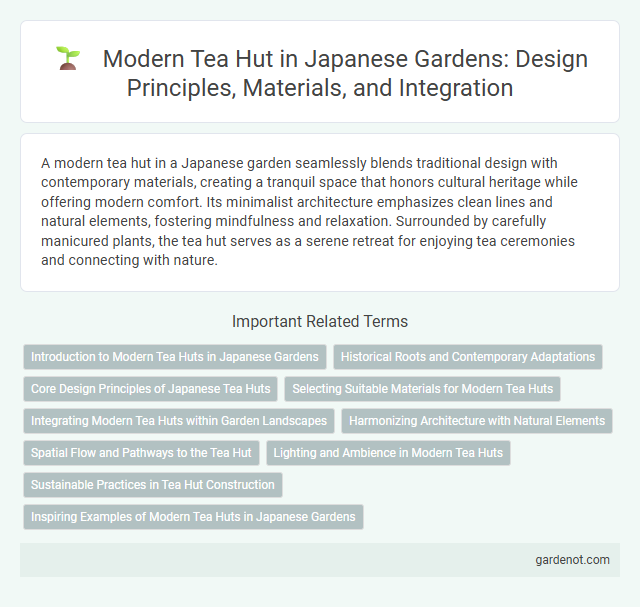A modern tea hut in a Japanese garden seamlessly blends traditional design with contemporary materials, creating a tranquil space that honors cultural heritage while offering modern comfort. Its minimalist architecture emphasizes clean lines and natural elements, fostering mindfulness and relaxation. Surrounded by carefully manicured plants, the tea hut serves as a serene retreat for enjoying tea ceremonies and connecting with nature.
Introduction to Modern Tea Huts in Japanese Gardens
Modern tea huts in Japanese gardens blend traditional chashitsu design with contemporary architecture, enhancing the tea ceremony experience while harmonizing with natural surroundings. These structures incorporate sustainable materials and minimalist aesthetics, reflecting both cultural heritage and modern functionality. Emphasizing simplicity and tranquility, modern tea huts serve as serene spaces for mindfulness and social connection within the garden's landscape.
Historical Roots and Contemporary Adaptations
The modern tea hut draws inspiration from traditional chashitsu, integral to the Japanese tea ceremony since the 16th century. Its minimalist design emphasizes natural materials like cedar and bamboo, reflecting Zen aesthetics while accommodating contemporary needs such as enhanced ventilation and modern seating. This fusion preserves cultural heritage while adapting to present-day lifestyle and environmental considerations.
Core Design Principles of Japanese Tea Huts
Modern tea huts in Japanese gardens emphasize simplicity, natural materials, and harmonious integration with the surrounding landscape, reflecting the core design principles of wabi-sabi and minimalism. The structure often features tatami flooring, shoji screens, and subdued colors, fostering a serene atmosphere for tea ceremonies. Attention to spatial proportion and subtle craftsmanship highlights the appreciation of imperfection and tranquility essential to the tea culture.
Selecting Suitable Materials for Modern Tea Huts
Selecting suitable materials for modern tea huts involves prioritizing natural elements like bamboo, cypress, and cedar, which provide durability and aesthetic harmony with traditional Japanese garden settings. Incorporating eco-friendly materials such as reclaimed wood and weather-resistant composites ensures sustainability while maintaining the serene atmosphere essential to the tea ceremony. Proper material choices also enhance the structural integrity and longevity of the tea hut, blending modern functionality with cultural authenticity.
Integrating Modern Tea Huts within Garden Landscapes
Modern tea huts harmonize minimalist design with traditional Japanese aesthetics, creating serene focal points within garden landscapes. Utilizing natural materials like wood and bamboo, these structures emphasize simplicity and craftsmanship, blending seamlessly with surrounding flora and water features. Their integration fosters contemplative spaces that enhance the sensory experience of the garden while respecting cultural heritage.
Harmonizing Architecture with Natural Elements
Modern tea huts in Japanese gardens emphasize seamless integration of architecture with natural elements by utilizing materials such as bamboo, wood, and stone to blend with the surrounding landscape. Open designs and large windows frame views of carefully curated gardens, enhancing the sensory experience of tranquility and nature's beauty. This harmonious approach reflects traditional aesthetics while incorporating contemporary minimalism to create serene, functional spaces for tea ceremonies.
Spatial Flow and Pathways to the Tea Hut
The modern tea hut in a Japanese garden emphasizes seamless spatial flow through carefully designed pathways that guide visitors naturally toward the structure. Stone stepping paths and gravel trails integrate with surrounding flora to create a tranquil journey, enhancing the meditative experience before entering the hut. These pathways balance aesthetics and function, ensuring smooth movement while maintaining the garden's harmonious atmosphere.
Lighting and Ambience in Modern Tea Huts
Modern tea huts incorporate soft, ambient lighting that enhances the tranquil atmosphere essential to the Japanese tea ceremony. LED fixtures with warm tones highlight natural materials like bamboo and wood, creating a serene and inviting space. Subtle illumination techniques emphasize simplicity and harmony, reinforcing the meditative experience within contemporary tea huts.
Sustainable Practices in Tea Hut Construction
Modern tea huts in Japanese gardens emphasize sustainable practices by utilizing locally sourced, renewable materials such as bamboo, reclaimed wood, and natural stone to minimize environmental impact. Energy-efficient design incorporates natural ventilation and lighting, reducing reliance on artificial climate control and electricity. These structures often integrate traditional craftsmanship with eco-friendly building techniques, promoting harmony between cultural heritage and environmental responsibility.
Inspiring Examples of Modern Tea Huts in Japanese Gardens
Modern tea huts in Japanese gardens blend traditional architecture with contemporary design, showcasing minimalist aesthetics and sustainable materials like bamboo and glass. Notable examples include Kengo Kuma's wooden tea house, which integrates seamlessly with nature through open structures and natural light. These inspiring designs emphasize tranquility, harmony, and a deep connection to the surrounding landscape.
Modern tea hut Infographic

 gardenot.com
gardenot.com